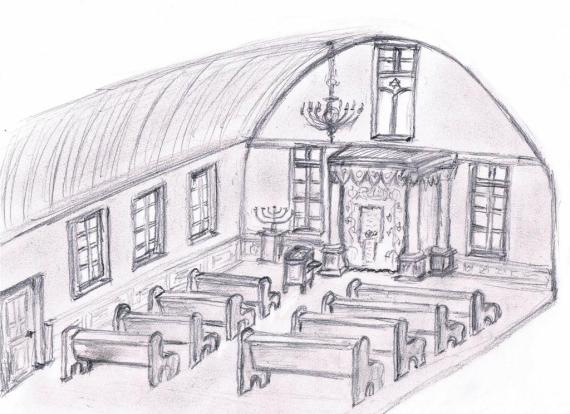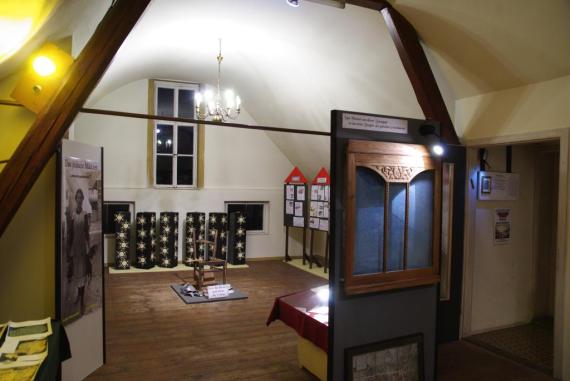Poppenlauerer Straße 4
97711 Maßbach
Germany
A synagogue or a prayer room was present at least since the time around 1700. Initially, such a prayer room was established in a house belonging to Barthel Hunefeldt. Then a prayer room could be established in the small castle (Eisenach life). Shortly before 1716 a new synagogue was built. From this year a document is preserved, in which is reported about closer circumstances to the building of the house of worship: The lords of Rosenbach would have given the timber for the construction. The building itself, however, was built on princely Saxony-Eisenach land. In 1747 the synagogue burned down. Despite the protest of the Protestant pastor, it was rebuilt.
Around 1860, the synagogue has been extensively renovated. In the process, the traditional lattices of the women's gallery were apparently removed, as in 1865 the Orthodox Rabbi Bamberger wanted to urge the congregation to reinstall the lattices. A new synagogue was dedicated in 1899. Services were celebrated in it until 1938. In January 1938, District Rabbi Dr. Menachem Ephraim preached in the synagogue for the last time.
In the pogrom night in November 1938, the interior of the synagogue was destroyed. By order of the SA-Standarte Bad Kissingen, all 60 to 70 men of the local Sturmabteilung gathered in the early morning of November 10, 1938, and were divided into groups. One group destroyed doors, windows and furniture in the synagogue. Torah scrolls were torn and trampled. A number of ritual items were taken from the synagogue and taken to an unknown location. The Torah shrine curtains and silver utensils, which dated back to the early days of the congregation, were destroyed. Afterwards, the SA people moved to Poppenlauer.
After the pogrom, the mayor made the Jewish residents pay RM 800 to repair the synagogue windows. He also offered them to sell the synagogue for RM 50. Master saddler Karl Geiling, in whose yard the synagogue stood, tried to acquire the building, but this proved very difficult. On the part of the only small Jewish community there were no objections to the sale to him in July 1942. The last two Jewish men - Sigmund Max Eberhardt and David Frank - "confirmed" in a document of 1942 their consent to the sale of the building to Karl Geiling.
Since the transfer of ownership to Karl Geiling had still not been completed in 1948, he was assisted by Simon Eberhardt, who had fled with his family to Argentina, by another letter that would allow the building to be sold.
In the end, the sale to Karl Geiling did take place. The latter made structural changes to the building. Externally, the gable front and the windows were changed, the small porch on the east wall in the area of the Torah shrine was removed. Inside, a false ceiling was inserted at the level of the former women's gallery. Below the new ceiling, the saddler's workshop was established. Above, the building remained almost unchanged, here it was used as a storage room. The building remained in the possession of the Geiling family until 2012; in that year there was a change of ownership.
In the former synagogue, museum director Klaus Bub was able to set up an exhibition entitled "Maßbach unterm Davidstern". The exhibition reports on Jewish life in the village. In 2009, a Genizah (repository for religious writings and objects no longer in use) was discovered in the attic of the synagogue. In 2011, the former synagogue was included in the urban development concept of the market Maßbach.
Since 2016, there are plans to preserve the former synagogue for the future. As a first step, a concept is to be developed on how the former synagogue and the property can be used. The political community would like to take over the building and convert it with state funding to be applied for. The goal is a structural reconstruction of the former synagogue. For the eventual establishment of a museum, numerous documents as well as ritual objects are available on loan from the Münnerstadt Henneberg Museum. In December 2016, the municipality applied to the government of Lower Franconia for the inclusion of the "synagogue" measure in the "social city" funding program from 2017. For the period from 2018 to 2020, subsidies in the amount of half a million euros are to be applied for the former synagogue.
The adjacent house on Poppenlaurer Straße, which adjoined the synagogue or is built together with it, is also to be acquired. Until 1920 this building was in Jewish possession and was then acquired by saddler master Karl Geiling. He set up his workshop in the building (Schuhhaus Geiling). It was he who then also acquired the synagogue building in 1942.



Add new comment